Tested: The New Arc’teryx Backcountry Ski Boot and Avy Bag
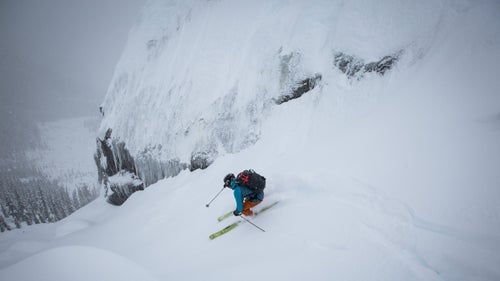
Arc’teryx is one of the fastest growing outdoor-gear companies, adding on average 40 employees per year and poised to move into a new factory and warehouse complex the size of four football fields by summer 2016. But any concerns that the company’s growth will dilute its focus on innovation and performance were left in a contrail of powder earlier this month when the company announced a big push into backcountry gear. Starting in fall 2016, the company will sell an airbag pack and ski touring boot. And that’s just the beginning. “You can expect to see more innovation in both lines in the coming years,” says Arc’teryx spokesman Chris Denny.
Last week, I joined a select group of journalists and Arc’teryx designers to . We travelled to Callaghan Country’s cozy Journeyman Lodge, southwest of Whistler, and spent three days snowmobiling, ski touring, and ice climbing. Both products performed exceptionally well, demonstrating that The Bird remains focused on doing what it does best: making rock-solid, beautiful, innovative gear.
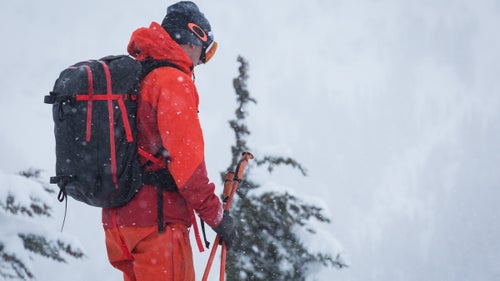
Arc’teryx spent five years and $2 million developing the Voltair Avalanche Airbag. Industrial designer Gordon Rose filed 28 patent applications alone on the inflation system’s engine. “We had to develop just about every part from scratch,” he says. “There’s nothing ‘stock’ in it.” Arc’teryx ditched the compressed gas canisters found in most avy packs in favor of a proprietary fan system. This self-contained unit allows for multiple deployments, which means users can practice blowing up the pack before heading into the field.
I found the pack carries nicely, thanks to its overbuilt harness. “We want it to feel comfortable even fully loaded and skis strapped to the back,” says Peter Hill, who designed the body of the pack. (Skis or boards carry vertically.) For an airbag pack the Voltair is relatively light: 7.6 pounds for the 30 liter and 7.1 pounds for the 20 liter.
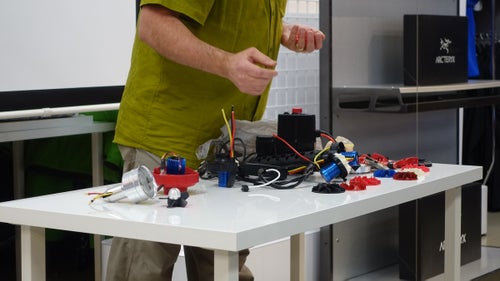
Designer Gord Rose went through 23 iterations of the fan before settling on the final one. Similar to the blower in a vacuum, its powerful, durable, and redundant. It will keep spinning and filling the air bag, even if an ice chunk gets sucked through the filters or a blade snaps. Power comes from a custom-designed, 25-volt lithium-polymer battery, rechargeable via a wall port. The battery packs enough juice to blow up the pack at least eight times on one charge at negative 30 Fahrenheit, but probably closer to 12 times at comfortable skiing temperatures. I blew my pack off five times over the week and the battery power light still registered green, not yellow or red.
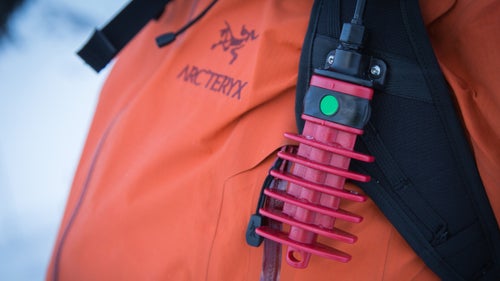
The trigger, which is connected to the engine via a piece of bike brake cable, sits on the left shoulder strap and is unlike any other trigger on the market. It’s a plastic-molded handle that’s easy to grab blind and pull even with heavy mitts. The trigger has two positions: locked (red), and armed (green). Arc’teryx built in some redundancy here. It only takes a 20-degree twist of the handle to take it from locked to armed. I easily deployed my bag from a locked position while skiing just by twisting while pulling. Another nice touch: deployment requires at least a two inch pull on the trigger. The delay helps prevent blowing off the airbag by accident.
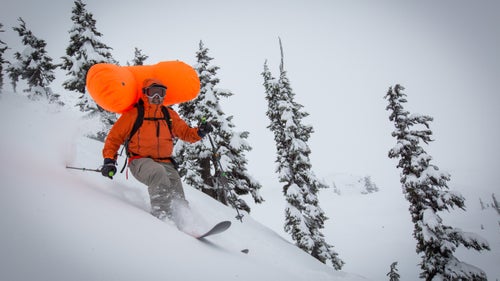
The 150-liter airbag stuffs into a compartment the size of a large goggle holder at the top of the pack. It inflates in under five seconds into a balloon that wraps around the head slightly: after deploying it during a run, I could feel it behind my head but it didn’t bother me or block my peripheral vision. The fan runs for about seven seconds and then continues to pulse more air into the bag until you physically turn it off at the battery. Deflation takes a few minutes: you poke a special straw through a valve and push all the air out, stuff the air bag back into its pocket, zip the zipper across, snap down the lid, and pull out the straw.
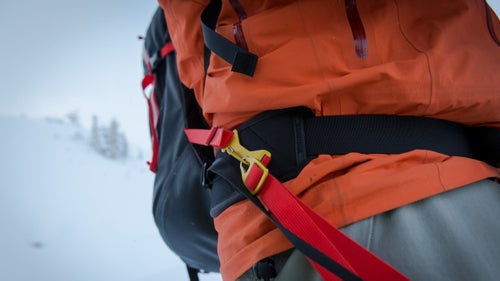
Like all airbag packs, the Arc’teryx one has a leg loop to keep the pack in place during an avalanche. To make the leg loop as user-friendly as possible, Arc’teryx designed a quick release clip that’s easy to use with gloves on.
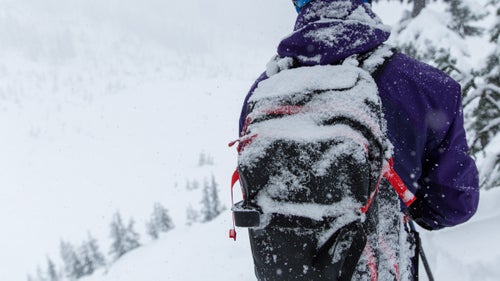
“It’s a great ski pack all on its own,” says Peter Hill, designer of the bag. “It just happens to have a balloon that pops out of its head.” It comes in two sizes—20 liter and 30 liter—and both are built with Arc’teryx’s AC2 pack fabric. With coated fabric, taped seams, and waterproof zippers, it’s almost a dry bag.
The 20-liter version has one main zip pocket, while the 30-liter has a tool pocket and a bigger main pocket. The volumes are exclusive of the airbag system—meaning you actually get 20- and 30-liters of space. I used the 30 liter and it was quite roomy, easily swallowing crampons, a helmet, and my usual day-touring kit.
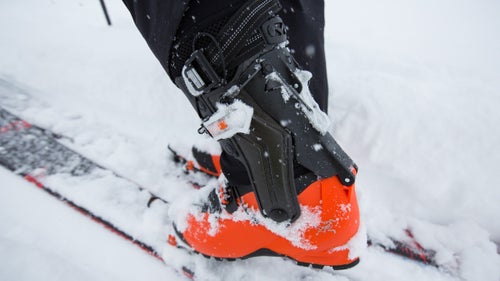
Arc’teryx jumped into footwear in 2013 with a pair of innovative hikers. Now we know they were just a warm up. “The Procline ski boot was always what we were working towards,” says Frederico Sbrissa, the footwear product line manager. “Our athletes were taking two boots with them for winter mountaineering objectives: approaching in a ski boot and then changing into a climbing boot. No one was making one boot that could perform at an optimal level climbing, ski touring, and descending.”
The most innovative feature of the boot may be the rear cuff. While most other ski boots use one piece of plastic that wraps around the lower leg, the Procline’s cuff is split in two. In walk mode this allows both pieces of the cuff to move independently, eliminating any rigidity to the upper boot. On the foot, this translates into full ankle mobility: 70 degrees of forward and backward range and 30 degrees side to side. The result: freedom. Not only was the boot incredibly comfortable—it felt more like a hiking boot than a ski boot—it also allowed more precision when ice climbing and better traction ski touring. When skinning across wind hammered snow, the lateral flex let my ski follow a sloped track while my leg stayed straight. The cuff comes in an all carbon fiber construction or a mix of carbon and plastic.
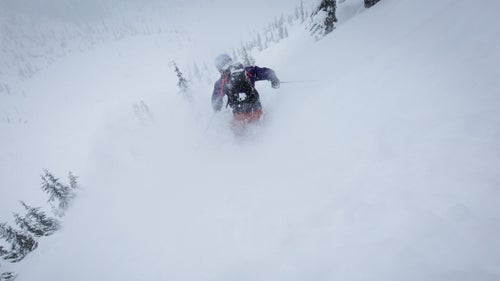
Put the Procline into ski mode and a cable wrapped around the whole boot tightens up, locking the split cuff together, stiffening the whole boot. Although I was skiing in a pair of boots a size too big, they still felt responsive. I never lacked for stiffness or control, in conditions ranging from dust-on-crust to knee-deep powder to tight trees. They had comparable downhill performance to similar three buckle touring boots I have tried.
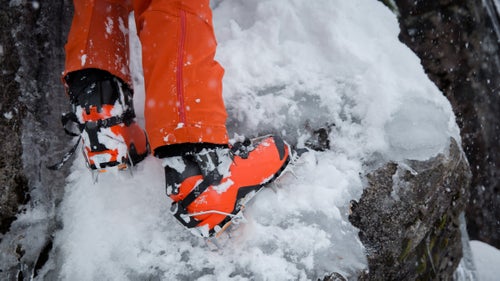
To optimize its climbing ability, the toe and heel overhangs were shortened, leaving just enough lip for crampon bails. The Vibram sole is the same one used on many mountaineering boots, with aggressive lugs and rubber sticky enough to grab rock. For skinning, it has certified Dynafit tech binding fittings.